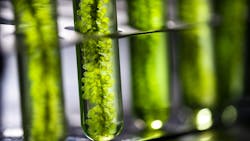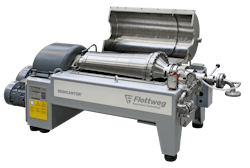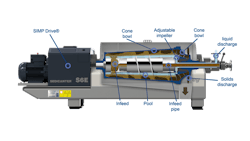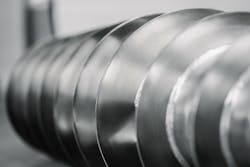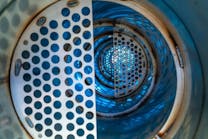Tackling challenges with pharmaceutical separation
Algae have a number of convincing properties that make it ideal for use in developing synthetic drugs. Marine algae, for example, is a great source of bioactive metabolites and is often used in the pharmaceutical industry for drug development. However, separating this kind of soft, flowing material that contains a high concentration of very fine particles (also found in yeast, bacteria or fungi fermentation processes) continues to be a challenge for process manufacturers.
Fermentation processes are a central process step in industrial biotechnology. The chemical, pharmaceutical and food and beverage industries rely on fermentation to transform bacteria, yeasts or fungi into valuable products and materials. Mechanical separation technology allows these fermentation products to be obtained from the fermentation broth.
Separation solution for the pharmaceutical industry
An industry-standard process for this type of separation includes using both a decanter and a disc stack separator. However, a hybrid, alternative approach using a Sedicanter effectively separates these types of materials with only one machine needed.
Like a decanter, a Sedicanter can accommodate large quantities of solids and just like a separator, it can reach increased G-forces to separate out the fine particles. The result is a dry cake and highly clarified liquid phase (i.e., centrate) in a single step.
Another key to boosting separation efficacy comes from the flow of the material and the solid and liquid phases. Generally speaking, there are two options for direction of flow:
- Countercurrent, where they flow in opposite directions (typically realized in decanters).
- Cocurrent flow, where liquids flow in same direction as the solids.
The Sedicanter effectively uses cocurrent flow. This results in less turbulence in the bowl and the improved settling of fine particles. The versatile machine operates continuously rather than in batches. Its automatic adjustable impeller regulates the liquid level in the machine and allows on-the-fly adjustments for varying feed conditions to maintain consistent processing results.
The result is efficient, reliable, customer-specific processes for obtaining organic acids such as lactic acid, citric acid and succinic acid, as well as other organic materials. Centrifuges are also used to clean nutrient media before their use in fermentation processes.
A centrifuge will first separate the biomass from the fermentation broth. Depending on the specific process and fermentation medium, they can achieve a dry substance value (DS) of 20% to 45%. For higher yields, the solid can be mashed again and taken through additional extraction steps. A Sedicanter can separate even the finest of solid particles out of the clarified fermentation broth.
This technology is useful for many applications in the food and beverage, pharmaceutical and biofuel industries. In addition, clean-in-place (CIP) and hygienic design features make it suitable for applications where safety and cleanliness are critical, such as in the pharmaceutical industry.
The role of CIP in pharmaceutical processing
CIP is a method used to clean production facilities and pipelines. The plant is cleaned in circular or continuous processes, without prior disassembly. Originally developed for the food industry and dairies, CIP cleaning is primarily used in the food and beverage and pharmaceutical industries. In biotechnology applications, CIP cleaning is usually followed by sterilization-in-place (SIP) cleaning.
The CIP process varies based on the product that is being processed, but usually involves the following steps:
- Pre-rinsing with water to remove coarse dirt
- Rinsing with a caustic solution or cleaning agent
- Intermediate rinsing with water to rinse out the cleaning agent
- Rinsing with an acid
- Rinsing clean with water
- Optional: Disinfection, for example, using post-rinse disinfection: The plant remains filled with disinfectant over the weekend after the end of production, for example.
Operators normally control the CIP cleaning of production facilities automatically. The advantage is that the temperature, duration and sequence of the media to be cleaned are automatically regulated.
Decanters in a hygienic production environment
In comparison to non-food processing, production processes in the food, animal feed, pharmaceutical and cosmetics industries place increased demands on hygiene.
The challenge of creating a hygienic production environment is to design machines and processes so that they can be cleaned to the highest possible standards, while at the same time complying with all the necessary standards and achieving the required separation results.
When designing a cleaning process, the focus is always on achieving the best possible reproducible result. It is important to consider the resources and personnel costs involved, as well. From the outset, engineering must ensure that cleaning cycles are designed efficiently.
During the design of hygienic decanters and the associated peripherals, the focus is on avoiding dead zones in machines and systems — areas where difficult-to-remove contaminants and product residues accumulate.
Designers can adjust the quality and form of the product contact surfaces in order to quickly achieve the desired cleaning result. Depending on the product to be processed, hygienic decanters are equipped with cleaning nozzles in different positions. Cleaning can be individual or fully integrated into the automatic CIP process of a complete system.
The cleaning system can be designed as a non-recirculating cleaning system or as a stacked system with recirculation of the cleaning media. Hygienic decanters can be integrated into existing or new processes in a configuration specific to the customer and the process.
The parameters required for CIP cleaning are stored separately in the control unit so that the cleaning process can be reproduced. The parameters can also be adapted to changing process conditions. An automated and remote-adjustable impeller makes the CIP process much easier. If the pond depth of the decanter is changed, each area within the centrifuge can be rinsed and cleaned sufficiently and purposefully without intervention by operating personnel.
For machines, apparatus and plants used in hygienic production environments, compliance with all the necessary framework conditions is already taken into account during the design and construction process. In addition to a variety of other aspects, the USDA design notes and the EHEDG guidelines are implemented as comprehensively as possible. For example, the surfaces in contact with the product are identified, the appropriate materials and auxiliaries are selected for the application, and dead zones are avoided by design.
In the manufacturing of hygiene-sensitive products, it is important to know which critical control points are of essential importance for effective level control or for a HACCP concept. In principle, machine and plant engineering can create the necessary foundation by designing the equipment and configuring the plant to meet hygiene criteria.
Working with the customer, a validation process can be performed for separator systems intended for use in hygienic production processes using the classic riboflavin test. By request, other procedures can be performed, or contamination can be simulated based on the subsequent process.
It is important to ensure that all machines can be integrated into the process in such a way that it is possible to take samples directly from the incoming product or cleaning agent flow, as well as directly from the outgoing media. This means that, for example, the cleaning procedure can be adapted during commissioning or at a later date if the customer changes the product or application.
The right choice of material
To ensure that no undesirable impurities are transferred to the product during the manufacturing process, only carefully selected materials are used in high-quality hygienic decanters. All contact surfaces should be made of austenitic or austenitic-ferritic stainless steels. Elastomer seals and connectors should meet the requirements of international regulations and standards, such as EC 1935/2004, FDA and EHEDG recommendations. All lubricants used should be food grade and have H1 approval.
Oliver Willman and Lee Betkowski are pharmaceutical processing experts at Flottweg Separation Technology.
Flottweg Separation Technology
